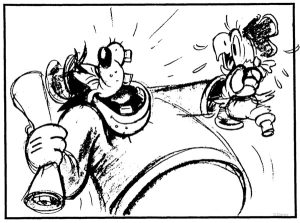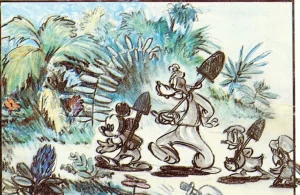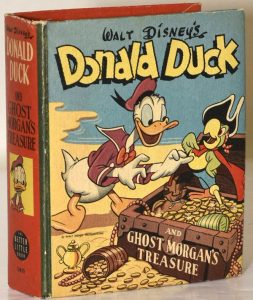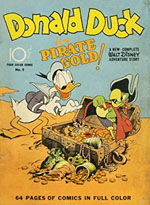
Suspended Animation #373
Over the years, numerous ideas were submitted for a full length animated film featuring Mickey, Goofy and Donald Duck. To the best of my knowledge the very first full proposal utilizing the terrific trio was submitted October 21st, 1939. Disney storymen Dick Creedon and Al Perkins wrote a typewritten proposal titled Pieces of Eight or The Three Buccaneers.
Creedon was credited as a writer on Snow White and the Seven Dwarfs. Carl Barks worked with Creedon on a story for the “proposed but never made” Mickey Mouse short cartoon, Mickey of the Mounted (August 1936). Perkins was credited as working on the Reluctant Dragon feature.
 The cartoon takes place at the Jolly Roger Inn in the old fashioned water front village called Fish Haven. The inside of the inn is fitted out like the inside of a ship and along the walls are pictures of famous pirates. In the cage above the bar is a crotchety, salty parrot who entertains patrons with wild sailor yarns.
The cartoon takes place at the Jolly Roger Inn in the old fashioned water front village called Fish Haven. The inside of the inn is fitted out like the inside of a ship and along the walls are pictures of famous pirates. In the cage above the bar is a crotchety, salty parrot who entertains patrons with wild sailor yarns.
The Inn is operated by Mickey, Donald, Goofy and Pluto. They complain about the lack of patrons and the fact that they are dead broke. Suddenly, in a gust of wind and rain, Pete enters and is given food and drink. Other strangers arrive and sit with Pete and tell Mickey and the gang to leave them alone.
Mickey notices that each of the strangers looks like the famous pirates whose pictures are on the wall. They are the descendents of the famous villains. Eavesdropping, Mickey and his gang discover that the pirates each have a fragment of a treasure map. The villains grab the parrot and run off to their ship, The Vulture.
Mickey and the gang follow and disguise themselves as sailors to get abroad the ship to try and rescue their parrot. However, their disguises fool no one and they are kicked off the ship.
 Saying goodbye to Pluto (actually tying him up on the dock), Mickey, Goofy and Donald hide themselves in empty burlap bags and are hauled onto the ship. However, Pluto breaks free and chases the ship and at a bridge across the mouth of the harbor, jumps into the crow’s nest with such force that he knocks himself out.
Saying goodbye to Pluto (actually tying him up on the dock), Mickey, Goofy and Donald hide themselves in empty burlap bags and are hauled onto the ship. However, Pluto breaks free and chases the ship and at a bridge across the mouth of the harbor, jumps into the crow’s nest with such force that he knocks himself out.
On board, Pete and his men torture the parrot “in some menacing but harmless way such as tickling him” and get the parrot to reveal the location of the treasure. The gathering is broken up by howls that the superstitious crew thinks might be the ghost of Robinson Crusoe on whose island the treasure is buried. It is Pluto stuck in the crow’s nest. However, Pete is not fooled and chases Pluto into the hold where the pooch unwittingly reveals the hiding place of Mickey, Donald and Goofy.
The pirates decide to make the gang work for them during the voyage like peeling potatoes, swabbing the decks, etc. and then they will throw them to the sharks when they are finished. During the course of the voyage, Mickey and the gang have hidden a lifeboat, but when they attempt to escape they spill most of their supplies into the ocean.
 The trio of friends with Pluto face a number of misadventures on the lifeboat including mirages and near starvation. Eventually, the boat runs aground on the very island they have been looking for and they are rescued by lovely native dancing girls who fawn over them and feed them.
The trio of friends with Pluto face a number of misadventures on the lifeboat including mirages and near starvation. Eventually, the boat runs aground on the very island they have been looking for and they are rescued by lovely native dancing girls who fawn over them and feed them.
However, Mickey has not lost the reason for them being there, and with Pluto sets off into the mysterious jungle. They do find a treasure chest, but it is empty. They follow a winding path up to a stockade and poke around until they find where Crusoe has hidden the pirate treasure.
While Mickey and Pluto celebrate, Crusoe and his Man Friday arrive. In the distance, they hear jungle drums getting louder and using his telescope, Crusoe sees the natives marching Donald and Goofy up to the crater of a huge volcano. Mickey, Pluto and Crusoe rescue Donald and Goofy and take them back to the stockade.
 Pete and his crew have discovered the empty treasure chest and have tracked Mickey to Crusoe’s home. The villains mount an attack but Crusoe doesn’t care whether they take the gold or not. It has no value to him on the island and he intends to stay on the island the rest of his life. Mickey sparks Crusoe to action when he tells them that the pirates are holding Crusoe’s beloved parrot hostage.
Pete and his crew have discovered the empty treasure chest and have tracked Mickey to Crusoe’s home. The villains mount an attack but Crusoe doesn’t care whether they take the gold or not. It has no value to him on the island and he intends to stay on the island the rest of his life. Mickey sparks Crusoe to action when he tells them that the pirates are holding Crusoe’s beloved parrot hostage.
Crusoe’s homemade defenses are pitted against machine guns, tear gas bombs and more. In the heat of the battle, Mickey vaults over the stockade to battle Captain Pete in hand-to-hand combat to rescue the parrot. This battle finally ends at the edge of the volcano crater with both combatants rolling over the edge toward the fiery lava below.
Pete’s crew is turned over to the natives to be tossed into the volcano. Suddenly, a charred and ruffled parrot flies in to take everyone to the volcano where Mickey is not dead but hanging by the seat of his pants to a piece of lava sticking out from the side of the crater. With one hand, he hangs on to the rock and with the other he hangs on to Pete.
Mickey and Pete are pulled up to safety and the finale is Mickey and the gang sailing home with their ship full of treasure. All of the cutthroats are in chains doing the work on the ship. Crusoe who is newly reunited with his beloved parrot, waves from the shore.
Over the next two years, several storymen including Homer Brightman, Harry Reeves and Roy Williams reworked the idea and re-titled the story Morgan’s Ghost. Nearly 800 storyboard drawings were attached to this new treatment, including an alternate ending as well as alternate gags for various scenes.

The West Coast editor of Western who was preparing material for Dell comic books, Oskar LeBeck, was given permission to look through the Disney files of cartoon ideas that were shelved. He found the over 800 numbered sketches for Morgan’s Ghost and was instantly struck that most of the work had already been done in terms of visualizing the story.
LeBeck felt it could easily be adapted into an original lengthy Donald Duck comic book story substituting Donald’s nephews for the Mickey and Goofy. Bob Karp, who was supplying gags for the Donald Duck comic strip at the time, was brought in to prepare a script based on the storyboard.
 Karp took Photostats of the storyboards and re-scripted them for the comic book Donald Duck Finds Pirate Gold released in late 1942. Karp concentrated on the action sequences, limiting the dialogue in the final script.
Karp took Photostats of the storyboards and re-scripted them for the comic book Donald Duck Finds Pirate Gold released in late 1942. Karp concentrated on the action sequences, limiting the dialogue in the final script.
John Rose, who was head of the story artists for the animated shorts suggested Carl Barks and Jack Hannah as artists to illustrate the script into the final comic book story. Not only Donald Duck storymen, Barks and Hannah were both talented cartoonists, as well and were professional artists before they were hired at Disney.
Barks and Hannah divided up the drawing chores. Barks drew pages 1, 2, 5 and 12-40 with the rest being done by Hannah. In general, Barks drew the exterior scenes and Hannah the interior scenes.
The book was released in the Dell Four Color series. It was Four Color No. 9 and officially titled Donald Duck Finds Pirate Gold (October 1942). It was so popular that it began a series of original comic book stories featuring Donald Duck. Barks even left the Disney Studios and became one of the main writers and artists for the Disney duck comic book stories.


 Jim Korkis is an internationally respected animation historian who in recent years has devoted his attention to the many worlds of Disney. He was a columnist for a variety of animation magazines. With his former writing partner, John Cawley, he authored several animation related books including The Encyclopedia of Cartoon Superstars, How to Create Animation, Cartoon Confidential and Get Animated’s Animation Art Buyer’s Guide. He taught animation classes at the Disney Institute in Florida as well as instructing classes on acting and animation history for Disney Feature Animation: Florida.
Jim Korkis is an internationally respected animation historian who in recent years has devoted his attention to the many worlds of Disney. He was a columnist for a variety of animation magazines. With his former writing partner, John Cawley, he authored several animation related books including The Encyclopedia of Cartoon Superstars, How to Create Animation, Cartoon Confidential and Get Animated’s Animation Art Buyer’s Guide. He taught animation classes at the Disney Institute in Florida as well as instructing classes on acting and animation history for Disney Feature Animation: Florida.




















































Evidently the Creedon and Perkins typescript showed a lot of promise, but some plot points needed ironing out. If Robinson Crusoe didn’t care about the pirate’s gold, then why did he hide the treasure in his stockade? And if the parrot originally belonged to Robinson, how did it wind up at the Jolly Roger Inn?
It’s interesting to speculate what this feature might have been like if it had been made. Think of the elaborate and exciting action sequences in “Mickey’s Man Friday” of 1935, and imagine how Disney’s artists might have handled such a battle scene with a few more years of training and experience under their belts. But all in all, I’m glad that Pinocchio, Dumbo, Fantasia and Bambi were made instead, and that the pirate story was successfully adapted for another medium. This is one of those “best of all possible worlds” stories.
Henry Morgan’s pirate treasure also figured in an episode of The Munsters, when Herman and Grandpa dug up his treasure chest in their back yard in suburban Mockingbird Heights.
The story was later revised and repurposed in the 1950’s as “Captain Hook and the Buried Treasure,” using the characters from Peter Pan.
The same pirate tale with Yellow Beak, minus the Ducks, was recycled several times, as in “Four-Color” No. 227 (1949) in The Seven Dwarfs tale. A more elaborate version as you point out was written by Del Connell for “Walt Disney’s Peter Pan Treasure Chest” No. 1 (January 1953) . It was illustrated by Dick Moores with Captain Hook substituting for Black Pete and the Peter Pan characters replacing the ducks.
Oddly, the story appeared yet again a decade later but this time in the non-Disney “Woody Woodpecker” No. 76 (1963) comic also published by Whitman, where Yellow Beak’s appearance and name remained unchanged as he interacted with Woody. Jack Hannah did a Cheerios giveaway comic book in 1947 titled Donald Duck and the Pirates which was an interesting variation re-telling of the original Donald Duck Finds Pirate Gold. It had a cover drawn by Carl Buettner but the artwork in the story is done by Hannah.
So maybe this story would have made a good animated feature after all. To me it is interesting that in all the different variations, the parrot Yellow Beak retains the same name and role.
What, no rough drafts of the “native dancing girls”?… awwww… paging Fred Moore!
Three Buccaneers looks like it woulda been a thriller. Dunno about a full-length, though. Maybe a two-reeler / featurette, like Popeye Meets Sindbad.